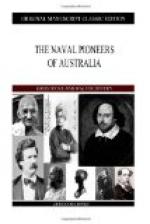“We went along three hundred leagues of coast, as I have mentioned, and diminished the latitude 2-1/2 degrees, which brought us into 9 degrees. From thence we fell in with a bank of from three to nine fathoms, which extends along the coast to 7-1/2 south latitude; and the end of it is in 5 degrees. We could go no further on for the many shoals and great currents, so we were obliged to sail south-west in that depth to 11 degrees south latitude. There is all over it an archipelago of islands without number, by which we passed; and at the end of the eleventh degree the bank became shoaler. Here were very large islands, and they appeared more to the southward. They were inhabited by black people, very corpulent and naked. Their arms were lances, arrows, and clubs of stone ill-fashioned. We could not get any of their arms. We caught in all this land twenty persons of different nations, that with them we might be able to give a better account to your Majesty. They give [us] much notice of other people, although as yet they do not make themselves well understood. We were upon this bank two months, at the end of which time we found ourselves in twenty-five fathoms and 5 degrees south latitude and ten leagues from the coast; and having gone 480 leagues here, the coast goes to the north-east. I did not search it, for the bank became very shallow. So we stood to the north.”
The “very large islands” seen by Torres were no doubt the hills of Cape York, the northernmost point of Australia, and so he, all unconsciously, had passed within sight of the continent for which he was searching. A copy of the report by Torres was lodged in the archives of Manila, and when the English took that city in 1762, Dalrymple, the celebrated geographer, discovered it, and gave the name of Torres Straits to what is now well known as the dangerous passage dividing New Guinea from Australia. De Quiros, in his ship, made no further discovery; he arrived on the Mexican coast in October, 1606, and did all he could to induce Philip III. of Spain to sanction further exploration, but without success.
Of the voyages of the Dutch in Australian waters much interesting matter is available. Major sums up the case in these words:—




